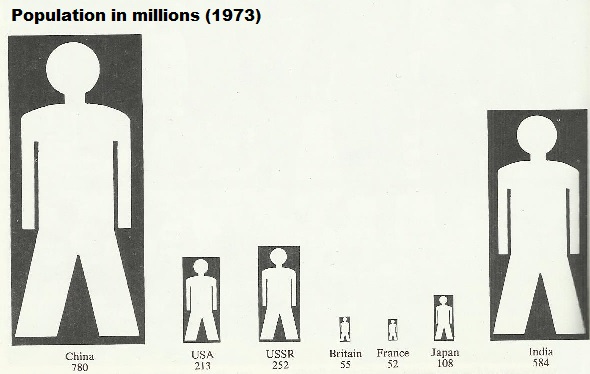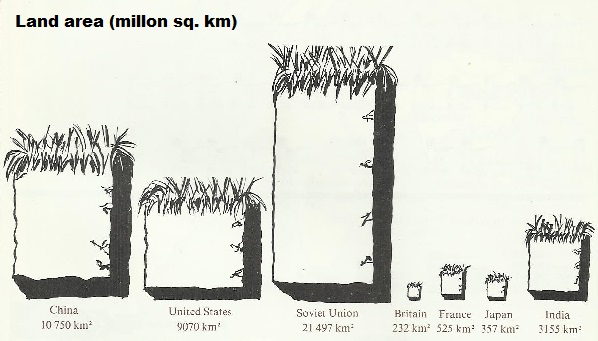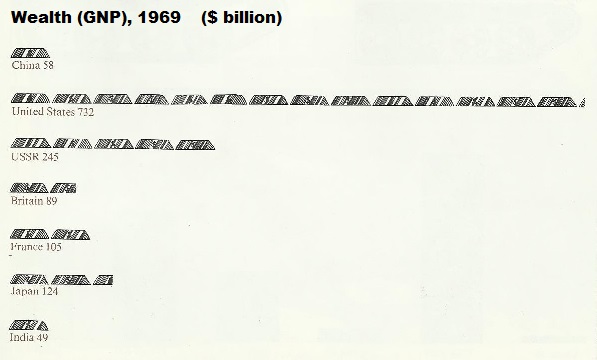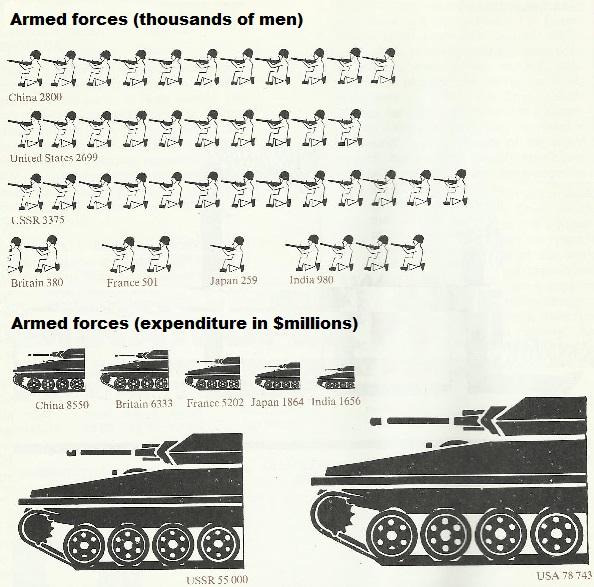
China's Relations with its Neighbours
Summary
This page summarises China's relations with other regional powers – Tibet, India, Vietnam, Taiwan and Hong Kong.
It asks the question: 'How far was China a superpower at Mao’s death?'
Links:
The following websites will help you complete the task:
Did Mao make China a Superpower?
China’s relations with Tibet
a. Invasion, 1950
In 1950 the PRC invaded Tibet ‘to expel imperialist aggressors’; the Tibetan army of 60,000 tried to resist, but was defeated in 6 months
b. 17-Point Agreement, 1951
This ‘agreement’, published without the knowledge of the Tibetan government, removed Tibet’s independence; it promised, however, not to change the Tibetan political system, religion or customs
c. Tibetan Rebellion, 1959
A Tibetan rebellion was brutally suppressed; the Dalai Lama fled to India
d. Tibetan genocide, 1959-62
The Chinese imposed Mandarin, forbade the Tibetans to grow grain or move their yak herds, and persecuted the Tibetan religion; the resultant famine killed a quarter of the population – a secret report by the Panchen Lama in 1962 accused the PRC of genocide
e. Cultural Revolution, 1966
During the Cultural Revolution, hundreds of thousands of Tibetans were killed as 'class enemies' who opposed communism
China’s relations with India
a. Hindi-Chin bhai-bhai, 1954-59
At first, Indian policy was ‘Indians and Chinese are brothers’; the Indians signed the Panch Shila (five principles) peaceful coexistence agreement with China, and worked hard to promote cultural exchanges
b. Dalai Lama, 1959
When the Dalai Lama fled from Tibet, the Indian government allowed him to establish a permanent base in Sikkim, in northern India
c. Sino-Indian War, 1962
War broke out over the disputed Himalayan province of Aksayquin when the Chinese built roads there; the Indians were defeated, but border disputes continued into the 1980s
d. Soviet Alliance, 1971
In 1971, India made a Treaty of Friendship with the USSR; China denounced India as ‘a tool of Soviet expansionism’
e. Nuclear testing, 1990s
Relations reached a new low when India developed nuclear missiles in the 1990s; however, although border relations remain difficult, the two countries have established extensive trade relations
China’s relations with Vietnam
a. Vietnam War, 1954-75
The Chinese gave huge support to the North Vietnamese, but on condition that they refused all Soviet Aid
b. Gulf of Tonkin, 1970s
When oil was discovered in the Gulf of Tonkin, China and Vietnam clashed over claims to various islands there
c. Sino-Vietnamese split, 1978
The Vietnamese attacked the ethnic-Chinese Hua minority, they invaded China’s ally Cambodia in 1976, and in 1978 they signed a treaty of friendship with the USSR; China ended its aid to Vietnam
d. Sino-Vietnamese War, 1979
The Chinese army invaded and devastated North Vietnam – both sides suffered heavy casualties in the two-week campaign; border clashes continued through the 1980s
e. Comprehensive Cooperation, 2000
After the collapse of the Soviet Union in 1991, relations improved, and in 2000 China and Vietnam signed a ‘Joint Statement for Comprehensive Cooperation’ which led to extensive trade agreements
China’s relations with Taiwan
a. GMD Islamic insurgency, 1950-58
Throughout the ‘fifties, the GMD waged a guerrilla war against the PRC in northern China, supplied from Taiwan
b. Taiwan Strait Crises, 1954 & 1958
Twice, relations across the Strait broke out into fighting; only the US fleet protected Taiwan from Chinese invasion
c. United Nations, 1971
Seeking detente with China, the US changed its policy and the PRC became the official representative of ‘China’ at the UN
d. The ‘Three Noes’, 1979
Under President Chiang Ching-kuo, Taiwan's policy was ‘no contact, no compromise, and no negotiation’
e. The 1992 Consensus
In 1992, Taiwan dropped its ‘one China’ policy, and – talking through arms-length organisations (SEF and ARATs) – the two countries moved from non-recognition to non-denial
Hong Kong
a. Liberated, 1945
Hong Kong was liberated by the British and Chinese in 1945; the PRC did not attempt to invade in 1949
b. Refugees, 1949-62
Hong Kong grew as refugees flooded in from China – businessmen from Shanghai in 1949, starving Chinese fleeing the Great Leap Forward; Hong Kong's industry and trade grew
c. Maoist Riots, 1967
During the Cultural Revolution, Mao encouraged Hong Kong communists and there were 6 months of strikes, rioting and terrorist bombings; Zhou Enlai, however, forbade an invasion, and Hong Kong survived
d. Joint Declaration, 1982
As the end of Britain’s lease neared, to prevent economic panic, the British government promised to return Hong Kong to China, on the assurance that China’s ‘one country, two systems’ policy would preserve Hong Kong’s business and freedom
e. Transfer, 1997
Last British Governor Chris Patten handed over Hong Kong peacefully to China; Hing Kong helped to stimulate China’s economic revolution
How far was China a superpower at Mao’s death?
a. UN Security Council, 1971
In 1971, China became a member of the UN security Council, giving it a veto on UN decisions
b. Military power
The Chinese had had the hydrogen bomb since 1967 and were a major nuclear power
c. Detente with the USA
The growing ‘normalisation’ of relations with the USA after the Shanghai Communique of 1972 greatly increased China’s prestige
d. Diplomatic influence
Many countries depended on Chinese aid and support, notably Chile and a number of states in Africa, where Zhou Enlai made a ten-country tour in 1963; by 1980, China did $1billion trade with Africa
e. Economic power
China was economically powerful, but income per head was still limited – compared to the western world, it was still economically less-developed
China's strength in 1976




Relations with other countries since Mao’s death
a. USSR
Relations remained hostile until the collapse of the USSR, after which China established trade and diplomatic relations with Russia, culminating in the Good-Neighbourliness Treaty of 2001
b. India
Relations reached a new low when India developed nuclear missiles in the 1990s; however, although border relations remain difficult, the two countries have established extensive trade relations
c. Vietnam
After the collapse of the Soviet Union in 1991, relations improved, and in 2000 China and Vietnam signed a ‘Joint Statement for Comprehensive Cooperation’ which led to extensive trade agreements
d. Taiwan
In the ‘1992 Consensus’, Taiwan dropped its ‘one China’ policy, and – talking through arms-length organisations (SEF and ARATs) – the two countries moved from non-recognition to non-denial
e. USA
The 1979 Joint Communique marked the formal establishment of diplomatic relations with the USA, and China now regularly holds Strategic Economic Dialogue talks with the US to discuss relations
Task
Read the source and write answers the questions that follow:
Deng Xiaoping's speech to the United Nations, 1975
China belongs to the Third World ... China is not a Super-Power, nor will she ever seek to be one.
What is a Super-Power? A Super-Power is an imperialist country which everywhere subjects other countries to its aggression, interference, control, subversion or plunder and strives for world hegemony ...
If one day China should change her colour and turn into a Super-Power, if she too should play the tyrant in the world ... the people of the world should identify her social-imperialism, expose it, oppose it and work together with the Chinese people to overthrow it.
Does this source prove that China was not a superpower in 1976?
With which country has China had the most
successful foreign relations since 1949:
• Taiwan
• Vietnam
• India?
How far was China a superpower at Mao’s death?